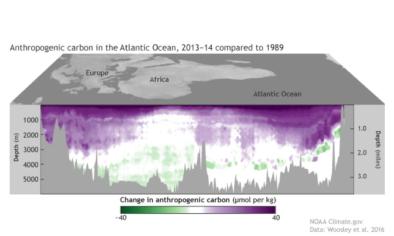Science Source
The exposure of the Great Barrier Reef to ocean acidification
- States the Great Barrier Reef (GBR) is founded on reef-building corals
- States that corals build their exoskeleton with aragonite, but ocean acidification is lowering the aragonite saturation state of seawater (Ωa)
- Uses a regional coupled circulation–biogeochemical model and observations to estimate the Ωa experienced by the 3,581 reefs of the GBR, and to apportion the contributions of the hydrological cycle, regional hydrodynamics and metabolism on Ωa variability
- Finds more detail, and a greater range (1.43), than previously compiled coarse maps of Ωa of the region (0.4), or in observations (1.0)
- Finds that most of the variability in Ωa is due to processes upstream of the reef in question
- Holds that future decline in Ωa is likely to be steeper on the GBR than currently projected by the IPCC assessment report
Related Content
Headline

Jun 6, 2018 | NOAA Climate.gov
Cruises cut a slice through the Atlantic's carbon pie
Science Source
| Nature Climate Change
Detecting regional anthropogenic trends in ocean acidification against natural variability
T. Friedrich, A. Timmermann, A. Abe-Ouchi et al
Science Source
| Biogeosciences
Using present-day observations to detect when anthropogenic change forces surface ocean carbonate chemistry outside preindustrial bounds
Sutton, Adrienne J., Sabine et al
Science Source
| Estuaries and Coasts
Is Ocean Acidification an Open-Ocean Syndrome? Understanding Anthropogenic Impacts on Seawater pH
Carlos M. Duarte, Iris E. Hendriks, Tommy S. Moore et al


